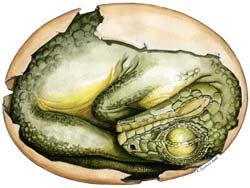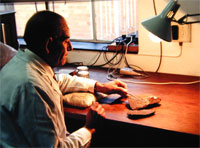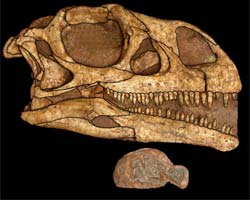Dinosaur Embryos
|
Two 190-million-year-old dinosaur embryos, out of a group of seven eggs, have been identified as the world's oldest dinosaur embryos found to date. Discovered in South Africa, they are also the oldest known embryos for any terrestrial vertebrate from anywhere in the world.
The embryos are of an Early Jurassic prosauropod dinosaur according to Dr Mike Raath, from the Wits Bernard Price Institute for Palaeontological Research (BPI). Raath is one of five authors who describe the embryos and their evolutionary significance in the leading international journal Science published on July 29, 2005. "The embryos belong to the early sauropodomorph dinosaur Massospondylus carinatus. These skeletons are quite common in South Africa and range in size from small juveniles to full adults, up to about 5m in length. This identification is a major coup, because embryos are often difficult to identify to species," says Raath.
The embryos provide significant insights into the growth and development of this early dinosaur. Raath explains that this discovery allowed the team to reconstruct in detail the growth trajectory of Massospondylus, from pre-hatchling to full adult - a first for any dinosaur. Prof Reisz, the project leader, points out that adults and juveniles of other types of dinosaur are known, but they are usually either recovered from bone beds, where the skeletons are broken up, disarticulated and scattered, or the rare articulated skeletons are not sufficient to reflect a growth series.
The result is an adult animal that looked very different from the embryo and was probably at least partly bipedal. In other cases where embryos and adults are known, as in the hadrosaurs or duck-billed dinosaurs, such dramatic changes in body proportions are not shown. The embryos also provide clues about the origin of the quadrupedal gait of the giant sauropods (the 'brontosaurs') of later times, which are descendants of the prosauropods. The embryo of Massospondylus looks like a tiny sauropod with massive limbs and a quadrupedal gait, which the authors believe shows that the quadrupedal gait of sauropods probably evolved through a phenomenon called paedomorphosis - the retention of embryonic and juvenile features in the adult. "Some people think that humans too are products of paedomorphosis," says Raath. The absence of well developed teeth in the two preserved embryos, which were clearly on the point of hatching, and the overall awkward body proportions suggest that the hatchlings required parental care of some kind for some time after emerging from the egg. The authors say that if this interpretation is correct, it constitutes the oldest known indication of parental care in the fossil record. |
Dinosaur Embryo Questions and Answers
| 1. An embryo in an egg - what is the scientific fuss all about? Articulated embryos from the Lower Jurassic Elliot Formation of South Africa are referable to the prosauropod dinosaur Massospondylus carinatus. Together with other material, the embryos provide significant insights into the ontogenetic development of this early dinosaur. The large forelimbs and head and horizontally held neck indicate that the hatchlings were obligate quadrupeds. In contrast, adult Massospondylus were at least facultatively bipedal. This suggests that the quadrupedal gait of giant sauropods may have evolved by retardation of postnatal negative allometry of the forelimbs. Embryonic body proportions and absence of well-developed teeth suggest that hatchlings of this dinosaur may have required parental care for some time after hatching. 2. What is so special about these embryos? Can you describe how they look? 3. How old are these embryos? What period are they from? 4. To which species do the embryos belong? 6. What does this tell us about the life history of these dinosaurs? 7. Does this identification shed any new light on the giant dinosaurs that walked the earth in later geological times? 8. Is there any sign of dinosaur parental care in these embryos? 10. Why were the eggs not touched for thirty years? 11. Who are the members of the research project? 12. Why is this project so exciting? |





